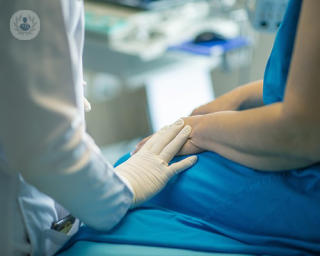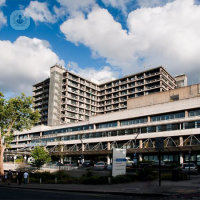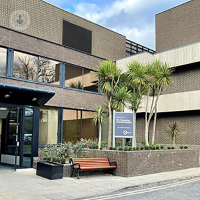What is hiatal hernia surgery?
A hiatal hernia occurs when a section of your stomach pushes up through an opening (called a hiatus) in your diaphragm. The diaphragm is a sheet of muscle located between the abdomen and chest. Hiatal hernia surgery involves pulling the stomach down into the abdomen and then making the hiatus opening in the diaphragm smaller.

Why is hiatal hernia surgery performed?
Hiatal hernia surgery is required when a hiatal hernia does not respond to medication or lifestyle changes. Sometimes, surgery is required for emergency cases. Surgery is also recommended if you have persistent symptoms, but do not want to be on medication long-term.
What does it involve?
Hiatal hernia surgery is usually performed using a laparoscope, which is a form of keyhole surgery. It involves a number of small abdominal cuts and the use of carbon dioxide to inflate a section of the abdomen. This allows the surgeon room to work. The laparoscope has a tiny camera on it, allowing the surgeon to see the inside of your body whilst they operate.
During this surgery, the stomach is returned to its correct position, and the diaphragm around the oesophagus is tightened to ensure no more acid moves back out of the stomach.
Surgery is performed under general anaesthetic to ensure there is no pain. This form of surgery takes 1-2 hours to complete.
How can I prepare for hiatal hernia surgery?
Before surgery, it is likely that your doctor will want to run tests on both how well the oesophagus moves, and how much acid is refluxed in a 24 hour period. Prior to surgery happening, the surgeon will explain fully the procedure and what to expect, as well as any possible side effects.
Such side effects include:
- Bloating and flatulence
- Dysphagia (difficulty swallowing)
What is recovery from hiatal hernia surgery like?
Patients who have had hiatal hernia surgery can leave the hospital after the general anaesthetic has worn off, which usually takes two to three days. Most patients are able to return to work after three to six weeks post-surgery. It is also recommended that after surgery, soft foods are eaten, such as soup or pureed vegetables for the first six weeks.
11-13-2012 08-21-2023Hiatal hernia surgery
What is hiatal hernia surgery?
A hiatal hernia occurs when a section of your stomach pushes up through an opening (called a hiatus) in your diaphragm. The diaphragm is a sheet of muscle located between the abdomen and chest. Hiatal hernia surgery involves pulling the stomach down into the abdomen and then making the hiatus opening in the diaphragm smaller.

Why is hiatal hernia surgery performed?
Hiatal hernia surgery is required when a hiatal hernia does not respond to medication or lifestyle changes. Sometimes, surgery is required for emergency cases. Surgery is also recommended if you have persistent symptoms, but do not want to be on medication long-term.
What does it involve?
Hiatal hernia surgery is usually performed using a laparoscope, which is a form of keyhole surgery. It involves a number of small abdominal cuts and the use of carbon dioxide to inflate a section of the abdomen. This allows the surgeon room to work. The laparoscope has a tiny camera on it, allowing the surgeon to see the inside of your body whilst they operate.
During this surgery, the stomach is returned to its correct position, and the diaphragm around the oesophagus is tightened to ensure no more acid moves back out of the stomach.
Surgery is performed under general anaesthetic to ensure there is no pain. This form of surgery takes 1-2 hours to complete.
How can I prepare for hiatal hernia surgery?
Before surgery, it is likely that your doctor will want to run tests on both how well the oesophagus moves, and how much acid is refluxed in a 24 hour period. Prior to surgery happening, the surgeon will explain fully the procedure and what to expect, as well as any possible side effects.
Such side effects include:
- Bloating and flatulence
- Dysphagia (difficulty swallowing)
What is recovery from hiatal hernia surgery like?
Patients who have had hiatal hernia surgery can leave the hospital after the general anaesthetic has worn off, which usually takes two to three days. Most patients are able to return to work after three to six weeks post-surgery. It is also recommended that after surgery, soft foods are eaten, such as soup or pureed vegetables for the first six weeks.


Hiatal hernia repair: Understanding the procedure, patient suitability, and success rates
By Mr Tom Wiggins
2024-11-21
We invited highly respected consultant in upper gastrointestinal and general surgery Mr Tom Wiggins to share his expert insight on hiatal hernia repair, giving key advice for patients preparing for this type of surgery. See more


Hiatal hernia treatment: what happens after surgery?
By Mr Sakhawat (Zak) Rahman
2024-11-20
Hiatal hernia surgery is usually performed as a minimally invasive procedure, known as laparoscopic surgery. Patients can usually return to work after about ten days, but it is important to follow the correct aftercare, including a liquid diet. See more


Hiatus hernia: cause, diagnosis and surgery
By Mr Krishna Moorthy
2024-11-19
Unlike more common types of hernias, a hiatus (or hiatal) hernia occurs when the upper part of the stomach pushes into the diaphragm with rarely any noticeable symptoms. Leading surgeon Mr Krishna Moorthy explains the cause, symptoms and treatment of a hiatus hernia. See more


Revisional hiatal hernia surgery for anti-reflux
By Professor Nick Maynard
2024-11-18
Revisional hiatal hernia surgery for anti-reflux is a complex procedure aimed at correcting issues that persist or arise after an initial surgery to treat a hiatal hernia or gastro-oesophageal reflux disease (GORD). See more
Experts in Hiatal hernia surgery
-
Mr Abhay Chopada
SurgeryExpert in:
- Polyps
- Bowel surgery
- Piles (haemorrhoids)
- Anal fistula
- Hiatal hernia surgery
- Colon cancer
-
Mr Sakhawat (Zak) Rahman
SurgeryExpert in:
- Cholecystectomy
- Laparoscopic hernia surgery
- Pancreas surgery
- Inguinal hernia
- Hiatal hernia surgery
- Gallbladder surgery
-
Mr P S Jambulingam
SurgeryExpert in:
- Weight loss
- Hiatal hernia surgery
- Gallstones
- Inguinal hernia
- Gastric cancer surgery
- Oesophageal cancer
-
Mr Sherif Awad
SurgeryExpert in:
- Bariatric surgery
- Acid reflux
- Hiatal hernia surgery
- Gallbladder surgery
- Minimal access surgery (keyhole surgery)
- Endoscopy
-
Mr Nagammapudur Balaji
SurgeryExpert in:
- Achalasia
- Acid reflux
- Laparoscopic hernia surgery
- Bariatric surgery
- Gallbladder surgery
- Hiatal hernia surgery
- See all

Chelsfield Park Hospital - part of Circle Health Group
Chelsfield Park Hospital - part of Circle Health Group
Bucks Cross Rd, Chelsfield, Orpington BR6 7RG
No existe teléfono en el centro.
By using the telephone number provided by TOP DOCTORS, you automatically agree to let us use your phone number for statistical and commercial purposes. For further information, read our Privacy Policy
Top Doctors

The Royal Free Hospital
The Royal Free Hospital
Pond Street, Hampstead. NW3 2QG
No existe teléfono en el centro.
By using the telephone number provided by TOP DOCTORS, you automatically agree to let us use your phone number for statistical and commercial purposes. For further information, read our Privacy Policy
Top Doctors

The Clementine Churchill Hospital - part of Circle Health Group
The Clementine Churchill Hospital - part of Circle Health Group
Sudbury Hill, Harrow HA1 3RX
No existe teléfono en el centro.
By using the telephone number provided by TOP DOCTORS, you automatically agree to let us use your phone number for statistical and commercial purposes. For further information, read our Privacy Policy
Top Doctors
-
Chelsfield Park Hospital - part of Circle Health Group
Bucks Cross Rd, Chelsfield, Orpington BR6 7RG, OrpingtonExpert in:
- Vascular Surgery
- Cardiology
- Colorectal surgery
- General Surgery
- Maxillofacial Surgery
- Orthopaedic surgery
-
The Royal Free Hospital
Pond Street, Hampstead. NW3 2QG, Central LondonExpert in:
- General Surgery
- Orthopaedic surgery
- Robotic Surgery
- Dermatology
- Obstetrics and Gynaecology
- Paediatrics
-
The Clementine Churchill Hospital - part of Circle Health Group
Sudbury Hill, Harrow HA1 3RX, West LondonExpert in:
- Abdominal ultrasound
- Abdominoplasty
- Acne
- Allergies bronchopulmonary
- Allergies nose and ears
- Allergy Dermatitis
- See all
- Most viewed diseases, medical tests, and treatments
- Weight loss injections
- Nipple discharge
- Abdominal pain
- Endovenous laser treatment (EVLA)
- Minimal access surgery (keyhole surgery)
- Head and neck cancer
- Neck lump
- Bariatric surgery
- Acellular dermal matrix (ADM)
- Prepectoral breast reconstruction







